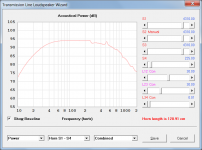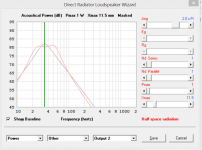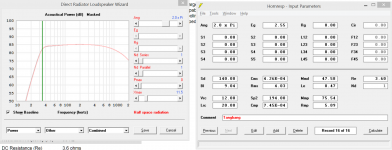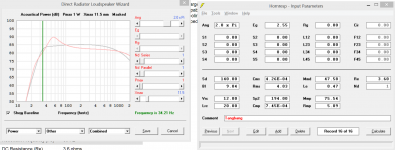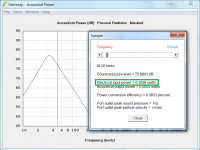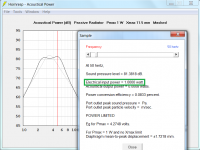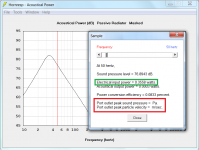On the subject of stuffing I am struggling with how to set the mks rayls/m figure. How could I find out this parameter for different acoustic adsorbent materials?
Hi Martin,
For some reason acoustical filling material manufacturers seem reluctant to publish airflow resistivity figures. This is somewhat surprising as flow resistivity is the key parameter when evaluating the relative performances of various absorbent filling materials. Suggest you try a Google search on "absorbent material mks rayls/m" (without the quotation marks).
Note that it is "absorbent" with a "b", not "adsorbent" with a "d". Adsorb and absorb have quite different meanings
Kind regards,
David
I was also thinking
Vrc = 0.
Lrc = 0.
S1 = box height x box width.
S2 = box height x box width.
L12 = box depth.
S3 = box height x box width.
L23 = 0.01
S4 = port height x port width.
L34 = port length.
Hi BP1Fanatic,
Just to clarify - for the above model S3 = port height x port width.
Note that the results will be slightly different to those calculated using GM's OD model.
Attachment 1 = GM's OD model
Attachment 2 = your Nd model (with S3 = port height x port width)
Kind regards,
David
Attachments
I have hunted down a few manufacturers of insulation to find the appropriate stuffing numbers. I'll try to post them sometime today. I found that when I was working on the design of an anechoic chamber. Kind of useful information on a whole lot of fronts in terms of acoustic radiation absorption.
I think I also have a paper that determines changes in absorption verus the angle of the source. Time to go a hunting.
Be werry werry quiet! I'm hunting technical papers!
I think I also have a paper that determines changes in absorption verus the angle of the source. Time to go a hunting.
Be werry werry quiet! I'm hunting technical papers!
Hi BP1Fanatic,
Just to clarify - for the above model S3 = port height x port width.
Note that the results will be slightly different to those calculated using GM's OD model.
Attachment 1 = GM's OD model
Attachment 2 = your Nd model (with S3 = port height x port width)
Kind regards,
David
Thank you for correcting S3 for me!
GM's graph definitely looks a lot better than mine.
Starts on Page 44.
View attachment Flow Resistivity.pdf
Acoustic flow resistivity measurements that are independently performed.
Lots of information available from ROXUL. And almost nothing directly from Owens Corning.
View attachment Flow Resistivity.pdf
Acoustic flow resistivity measurements that are independently performed.
Lots of information available from ROXUL. And almost nothing directly from Owens Corning.
Hello all,
I'm new to using Hornresp and have managed to produce a series of graphs which represent various enclosure designs for a Fostex FE206En driver.
- The black line represents the recommended BLH enclosure from Fostex
The graphs are very wavy, is this ok or am I doing it all wrong?
Any help or guidance would be much appreciated.
Craig
I'm new to using Hornresp and have managed to produce a series of graphs which represent various enclosure designs for a Fostex FE206En driver.
- The black line represents the recommended BLH enclosure from Fostex
The graphs are very wavy, is this ok or am I doing it all wrong?
Any help or guidance would be much appreciated.
Craig
Attachments
The graphs are very wavy, is this ok or am I doing it all wrong?
Hi Craig,
Could you please post a screenprint of the Input Parameters window showing the parameter values used in your design, and/or export the applicable Hornresp record and post the exported .txt file as an attachment. This will make it easier for people to provide constructive comment on your design, and on the simulation results you are seeing.
Kind regards,
David
Be werry werry quiet! I'm hunting technical papers!
Yes Elmer
a couple of questions....
with regards to adding mass to a PR, the help says "double click on the Mmp slider to add mass to each of the specified radiators". Does this mean the mass specified is per radiator or is the total mass applied to all radiators? I suppose it means the former but just wanted to check that.
secondly is it possible to simulate the effects of port compression? not by actually modelling port compression but simply by placing an upper limit on port velocity and adjusting the results of the simulation with that new constraint, e.g. state that max allowed port velocity is 10m/s. I don't know if this is feasible from a simulation point of view mind you.
with regards to adding mass to a PR, the help says "double click on the Mmp slider to add mass to each of the specified radiators". Does this mean the mass specified is per radiator or is the total mass applied to all radiators? I suppose it means the former but just wanted to check that.
secondly is it possible to simulate the effects of port compression? not by actually modelling port compression but simply by placing an upper limit on port velocity and adjusting the results of the simulation with that new constraint, e.g. state that max allowed port velocity is 10m/s. I don't know if this is feasible from a simulation point of view mind you.
Hi 3ll3d00d,
The added mass specified is per radiator. I will see if I can make the Help File description a bit clearer.
It could probably be done, but I can't see it happening in Hornresp .
.
Kind regards,
David
with regards to adding mass to a PR, the help says "double click on the Mmp slider to add mass to each of the specified radiators". Does this mean the mass specified is per radiator or is the total mass applied to all radiators? I suppose it means the former but just wanted to check that.
The added mass specified is per radiator. I will see if I can make the Help File description a bit clearer.
secondly is it possible to simulate the effects of port compression? not by actually modelling port compression but simply by placing an upper limit on port velocity and adjusting the results of the simulation with that new constraint, e.g. state that max allowed port velocity is 10m/s. I don't know if this is feasible from a simulation point of view mind you.
It could probably be done, but I can't see it happening in Hornresp
Kind regards,
David
speaking of PRs, it seems to behave oddly when you vary the power applied, output2 seems to deform completely.
Hi 3ll3d00d,
That's because when Pmax = 1 watt, and assuming that the system is not displacement-limited, the input power is 1 watt at all frequencies. When the Maximum SPL tool is not activated, and assuming that Rg = 0, the input voltage Eg is 2.55 volts at all frequencies, with the input power varying depending upon the electrical input impedance.
Attachment 1 shows the input power at 50Hz when the Maximum SPL tool is not activated, and the input voltage is 2.55 volts.
Attachment 2 shows the input power at 50Hz when the Maximum SPL tool is activated, and the input power is 1 watt.
Kind regards,
David
Attachments
Hi 3ll3d00d,
That's because when Pmax = 1 watt, and assuming that the system is not displacement-limited, the input power is 1 watt at all frequencies. When the Maximum SPL tool is not activated, and assuming that Rg = 0, the input voltage Eg is 2.55 volts at all frequencies, with the input power varying depending upon the electrical input impedance.
Attachment 1 shows the input power at 50Hz when the Maximum SPL tool is not activated, and the input voltage is 2.55 volts.
Attachment 2 shows the input power at 50Hz when the Maximum SPL tool is activated, and the input power is 1 watt.
Kind regards,
David
OK I see, I didn't realise that's what it was doing so thanks for clarifying.
Is there a way to vary power applied (in the "not maximum spl mode" style) in the loudspeaker wizard? I was trying to look at the displacement of a PR with weight applied. It seems the only way to add weight is via the loudspeaker wizard but that's the only power slider available. Should I experiment with weights in the filter wizard and then add the final value to Mmp in the main screen in order to then look at PR excursion?
Is there a way to do excursion plots at maximum SPL after you have set up a filter in the filter wizard?
Hi Mark,
Not that I am aware of.
Kind regards,
David
Is there a way to vary power applied (in the "not maximum spl mode" style) in the loudspeaker wizard? I was trying to look at the displacement of a PR with weight applied.
Hi 3ll3d00d,
Set the Xmax slider to 99.9 to prevent the results from being displacement-limited, and then vary Pmax as desired.
(Click on the Xmax slider, type 99.9 and then press the Enter key to set the slider value to 99.9).
Kind regards,
David
I just noticed yet another bug, missing port outlet pressure and velocity values in the attached Sample results.
The Sample results shown are for a passive radiator, not a port tube. The redundant references will be removed in the next update.
Thanks. I suspect there is something I'm fundamentally misunderstanding about the effect of this control. Is this the behaviour you'd expect from applying this to a PR system? If this is the expected behaviour, what does one use this functionality for? Does the discussion that starts around http://www.diyaudio.com/forums/subwoofers/119854-hornresp-33.html#post2464513 cover it?Hi 3ll3d00d,
Set the Xmax slider to 99.9 to prevent the results from being displacement-limited, and then vary Pmax as desired.
(Click on the Xmax slider, type 99.9 and then press the Enter key to set the slider value to 99.9).
Kind regards,
David
PR with some mass added in the loudspeaker wizard.
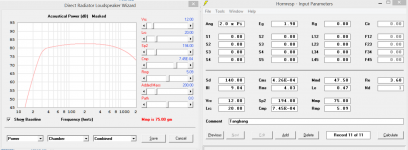
Now set xmax to 99, double click pmax and set to 1W
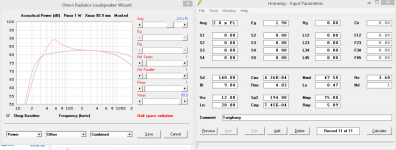
Hi 3ll3d00d,
See the Maximum SPL section in the Hornresp Help file for further information.
Yes.
People use it to get a sense of the overall maximum performance envelope of a given system (as limited by Pmax and Xmax). The feature was specifically requested and included way back in Version 13.00.
Yes.
Kind regards,
David
I suspect there is something I'm fundamentally misunderstanding about the effect of this control.
See the Maximum SPL section in the Hornresp Help file for further information.
Is this the behaviour you'd expect from applying this to a PR system?
Yes.
If this is the expected behaviour, what does one use this functionality for?
People use it to get a sense of the overall maximum performance envelope of a given system (as limited by Pmax and Xmax). The feature was specifically requested and included way back in Version 13.00.
Does the discussion that starts around http://www.diyaudio.com/forums/subwoofers/119854-hornresp-33.html#post2464513 cover it?
Yes.
Kind regards,
David
- Home
- Loudspeakers
- Subwoofers
- Hornresp
